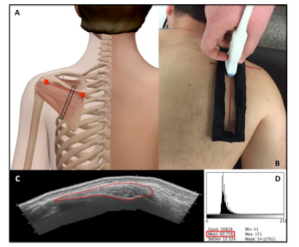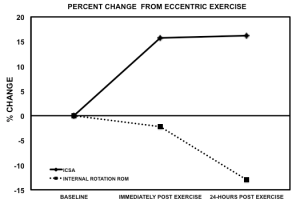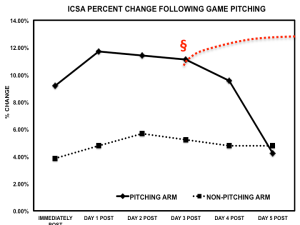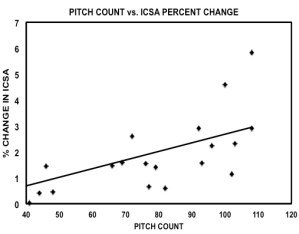Why did you do this study?

FIGURE 1: Assessment of ICSA and IEI. (A) Landmarks (red) and infraspinatus sagittal slice utilized (black); (B) Image capture procedures; (C) Determination of ICSA; (D) Determination of IEI from mean pixel gray scale analysis
Over 60 million youth and adolescents participate in organized sports per year, many of which are sustaining some type of musculoskeletal injury as a result of participation. Over 50% of these musculoskeletal injuries are caused by physical overuse, thus most are preventable. Musculoskeletal overuse injuries are caused by repetitive submaximal loading of the musculoskeletal tissue when sufficient rest/recovery is not adequately included as part of the training or participation. Thus, there is a significant need for children friendly, non-invasive markers that might detect musculoskeletal trauma resulting from sport participation as well can identify musculoskeletal recovery after a bout of athletic participation. Upper extremity-dominant sports commonly played by youth and adolescents, like baseball, swimming, and tennis lend themselves well to increased overuse injury risk because of the high repetition and forces placed on the musculoskeletal tissues during participation. This increased risk has prompted their respective organizations to publish guidelines for potentially reducing musculoskeletal injury risk. While these recommendations are helpful, overuse injury rates are still rising in the youth and adolescent sport population most likely because of the high intensity training and sport specialization that is commonplace amongst athletes today
Specific to baseball, throwing-related arm overuse injuries comprise more than half of all injuries occurring in baseball, with pitchers accounting for 73% of these injuries in the adolescent player. These overuse arm injuries result in significant time loss from participation, time loss from physical activity, decreased performance, and secondary pathologies later in life. This overuse injury risk is compounded in baseball given that youth/adolescent baseball participation often includes pitching on consecutive days, for multiple teams, and in the presences of arm pain and fatigue, resulting in an increased risk of injuries. Simply put, kids are playing and training too much, resulting in overuse injuries. The youth and adolescent baseball player are not getting adequate rest and recovery leading to injury. Given the high risk of injury associated with baseball participation without adequate rest and recovery, our overall goal is to develop a non-invasive child friendly model that allows us to better understand both the trauma and track rest and recovery following baseball participation.
What did you do and what did you find in this study?

FIGURE 2: Effects of eccentric humeral rotation repetitions on infraspinatus cross-sectional area (variable of interest in the current study) and shoulder rotation flexibility

FIGURE 4: Percent change in ICSA from pre-pitching baseline assessment. § Theoretical influence of subsequent pitching exposure prior to recovery. See C.1.2 for detailed explanation.
Our model utilizes non-invasive diagnostic ultrasound to obtain an image of the infraspinatus rotator cuff muscle. From this image we calculate both the cross-sectional area (as a measure of swelling) and echo intensity (as a measure of trauma and edema) FIGURE 1.
Previous work by the upper extremity research team has demonstrated that our infraspinatus model reflects the change that result from both eccentric humeral rotation-fatiguing repetitions (similar to pitching) (FIGURE 2) and from game participation pitching (FIGURE 3).
Additionally, we recently tested the recovery portion of our model by collecting the infraspinatus variables on our collegiate pitchers prior to pitching, and following (immediately and days 1-5 post game intensity pitching) during the fall intra-squad and exhibition season. In FIGURE 4, we demonstrate that the infraspinatus swelling increases following pitching, but returns to baseline at approximately day 5 days post pitching, suggesting it can reflect both trauma and recovery from pitching. The non-pitching arm appears not to change, suggesting that our model reflects the throwing arm trauma and is not due to systemic general baseball participation. Ultimately, our goal is to utilize this model to obtain a better understanding how adolescent pitchers are affected by pitching without the necessary rest and recover. For example, (see § in FIGURE 4) – an adolescent being asked to pitch after just 3 days rest will do so while the effects of that previous pitching bout are still present, thereby compounding overuse injury risk. Pitching on short rest for the same team or because of playing on multiple teams in the same season is common in adolescent baseball.
How do these findings impact the public?
The findings garnered from this model are both timely and impactful given the recent release of participation and rest recommendations from Major League Baseball/USA Baseball (Pitchsmart) as well the national media dubbing 2014 as the “Year of the Tommy John Epidemic” given the high number of star major leaguers who have sustained throwing-related elbow injury Often, the focus of the cause of these injuries is not the current participation at the professional level, but rather the amount of participation that has occurred when the injured players are younger. This recovery research model allows us to 1.) create, evaluate, and validate participation recommendations for those who participate in sports with high overuse injury risk, 2.) create evidence-based interventions (therapeutic modalities, pharmacology, and active rest models) for recovery following participation, and 3.) ultimately create evidenced-based strategies to prevent overuse injury in the youth and adolescent athlete.

